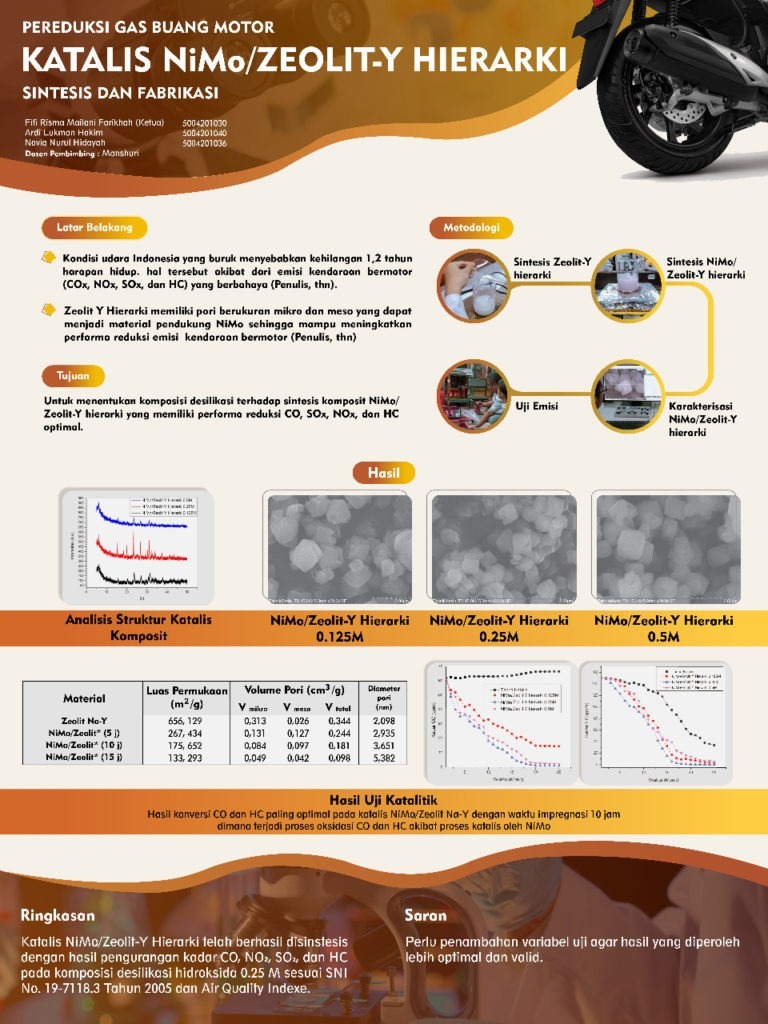ITS Student Team Created Synthetic Chemicals to Tackle Vehicle Pollution

(from left) Ardi Lukman Hakim, Novia Nurul Hidayah, and Fifi Risma Mailani Farikhah performing their writings
ITS Campus, ITS News – Pollution caused by the number of motor vehicles continues to increase, especially in major cities. In this setting, three students of the Chemistry Department of Institut Teknologi Sepuluh Nopember (ITS) initiated synthetic chemicals capable of reducing motor vehicle exhaust gas, by utilizing Nimo/Zeolite-Y catalysts that can optimally reduce vehicle emissions
The high use of motor vehicles in Indonesia is the largest contributor to poor air quality in several major cities in Indonesia. Not only does it cause air pollution, motor vehicle emissions such as carbon dioxide (CO2) also have an impact on climate change. “From these problems, we are trying to find solutions to reduce vehicle exhaust gases that are harmful to the environment,” explained Ardi Lukman Hakim, team leader.
In the early stages, he continued, the zeolite rocks disinter first, then disinterest again with the catalyst NiMo. “Referring to previous research, zeolite can only work when synthesized with substances that can be the catalyst, one of which is NiMo,” said the young man who is familiarly called Ardi.
The results of synthetic zeolite and NiMo resulted in NiMo/Zeolit-Y hierarchy with three concentrations. Namely concentrations of 0.125 M, 0.25 M, and 0.5 M. Ardi said that the results of this synthetic will characterize to find out more if the synthetic material is perfectly catalyzed and usable. “The most ideal composite catalyst is at a concentration of 0.25M,” said this student from Madiun.
Furthermore, Ardi explained that the most ideal concentration will be conducted in the emissions test phase. At this stage of the emissions test the catalyst will be precise with three hours, namely 5 hours, 10 hours, and 15 hours. The result of this impregnation will review the surface area, pore volume, and pore diameter of the catalyst.

The poster display of the ITS team when competing in the National Paper Competition 23rd FTP
Mainly the emissions test stage conducted tests whether catalysts can reduce harmful emission gases. Based on the results of CO and Hydrocarbon (HC) conversion, the Nimo/zeolite-Y catalyst hierarchy with an impregnation time of 10 hours is the most optimal. where the oxidation process of CO and HC due to Nimo catalyst work. “The result of the 10-hour impregnation also has a surface area. The volume of pores is not too large, So it is suitable for filtering emission gases,” he added.
Together with his two colleagues who are also students of the class of 2020, namely Fifi Risma Mailani Farikhah and Novia Nurul Hidayah, this team has won a gold medal in the scientific writing competition in the health and environment category organized by the Faculty of Agricultural Technology (FTP) Brawijaya University. The team guided by Mashuri SSi MT brought his idea in a paper titled Nimo/Zelolit-Y Catalyst Motor Exhaust Reduction of Synthetic Hierarchy and Fabrication. “This idea requires more research to add test variables to make the results more optimal and valid,” explained the young man born in 2002.
Finally, Ardi hopes that his team’s ideas can be further researched with adequate funding and facilities. “I hope this idea is not only an idea but can research more deeply and provide useful output for the Indonesian nation,” he concluded hopefully. (pan/ITS PUBLIC RELATIONS)
Reporter: Frecia Elrivia Mardianto
Related News
-
ITS Collaboration with BPBD East Java, Launching VR Disaster Simulation
ITS Campus, ITS News — Supporting anticipation of disasters and continuing to educate the public, Institut Teknologi Sepuluh Nopember
May 11, 2021 16:05 -
Supporting the Implementation of Innovative Ideas, ITS and IYSA Hold International Competition
ITS Campus, ITS News — Institut Teknologi Sepuluh Nopember (ITS) has once again proven its commitment to supporting the
May 11, 2021 16:05 -
ITS Maintains Informative Qualification for Five Consecutive Years at KIP Awards
ITS Campus, ITS News — Institut Teknologi Sepuluh Nopember (ITS) has once again successfully maintained its Informative Qualification predicate
May 11, 2021 16:05 -
ITS Strengthens Smart Eco-Campus through UI GreenMetric 2024
ITS Campus, ITS News — Institut Teknologi Sepuluh Nopember (ITS) has once again demonstrated its commitment to environmental concern
May 11, 2021 16:05
